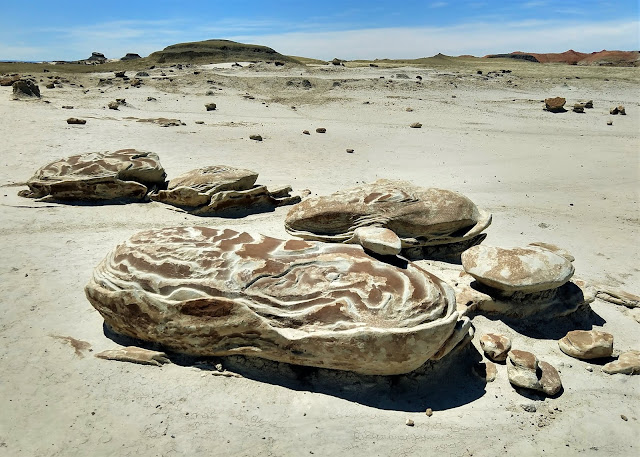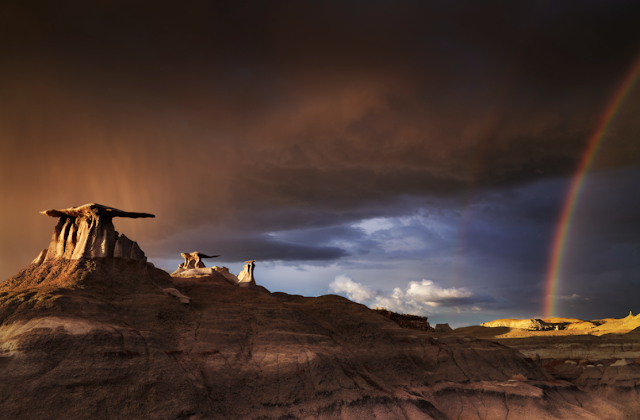A savage is not the one who lives in
the forest,
but the one who destroys it.
Unknown
 |
Ah Shi Sle Pah,
brain-like domes interspersed with toadstool-like hoodoos
This jarring erosive landscape
leaves one looking over their shoulders for dinosaurs
Beautiful yet haunting…
|
The
need to escape in nature gets stronger the longer I am hidden away from society
due to the novel coronavirus. A trip to safe,
solitary, and remote areas of New Mexico was in order. Up and down many bad, dusty, nearly
inaccessible, and often mis- or un- identified dirt roads, I finally immersed
myself in the Bisti Badlands and the Ah Shi Sle Pah Wilderness Area, near the
Navajo Indian Reservation.
If
remote and primitive is for you, you would probably appreciate the areas listed
above. They are not for the faint of
heart. If feeling like you are the only living
human for miles around enhances your aliveness, you would love to discover this
northwest corner of New Mexico.
After
a very long 35-mile drive along grassy and windy high desert plains dotted with
wild horses barely shedding their winter coats, protecting several newly born foals. It is nice to finally roam free but I could just
as easily get lost if not paying attention to my surroundings or to some simple
rules such as following riverbeds upstream to go easterly, and downstream, to
go westerly.
These
are places where you can allow yourself to see what is already there and let
that guide you to your next destination, a natural flow, at your own pace. Slow meanderings.
Dreamscape
or Landscape: Ah Shi Sle Pah Wilderness Area
Here,
nature seems to be in a mischievous mood.
Tall gnarly hoodoos look like the gathering of cloaked shamans in the
middle of a vast ancient desert. The
tortuous landscape is filled with an endless maze of passageways and secret
hiding spots that are mysterious, humorous, eerie, and awe inspiring all at
once. It is easy to expect a sudden tap
on the shoulder at any moment, inviting you to be part of a primordial trance.
 |
On the way to Fossil
Hoodoo
Akin to a stroll through
a garden on Mars?
|
 |
Floating circular rocks
Photographic heaven, best
at dawn and dusk when the light is kinder
Wilderness epiphany for
some
|
Sweet is the lore which Nature brings;
Our meddling intellect
Mis-shapes the beauteous
forms of things:
We murder to dissect.
Wordsworth
 |
Fossil Hoodoo,
softer rock topped with harder cap rock
Exotic, esoteric
sculptures
Hoodoo aka tent rock,
fairy chimney, or earth pyramid
|
 |
Petrified log
The area was a coastal swampy
conifer forest way back when
Inhabited by dinosaurs,
leaving fossilized evidence in their wake
|
 |
Petrified log
not fully agatized
Meaning the silicon oxide
(quartz) crystals have not filled the gaps in the cells
Not as sturdy or heavy,
rather brittle and less colorful
|
 |
I would call it Pagoda
Hoodoo
Otherworldly quality of
an austere alien landscape
Photos cannot convey the
true impact of this earth-scape
|
 |
So many shapes in such a
vast space, so little time
Phantasmagoric formations
of sandstone, mudstone, shale, lignite (coal)
Feel the history of the naked
land all around you
|
 |
Chocolate Mushroom
Hoodoos
Almost like a stone
forest
Imaginary world of
bizarre rock formations and hoodoos
|
 |
They look like toadstools
surrounded by baked yellowing fragile bentonite
Ancient and desolate
windswept landscape as far as the eye can see
|
 |
‘Table’
supported by two hoodoos
Humans have lived in the
area for more than 10,000 years
Much of this land is
sacred to the Navajo and other tribes
|
 |
Shade for a lonely plant
|
 |
Orange clinkers in
foreground, hoodoos beyond
|
 |
Folds upon folds upon
folds
|
 |
| A lonely yucca plant adds another dimension to these wrinkled hills |
Nature's Artwork: The Bisti Badlands / De Na Zin Wilderness Area
At Bisti, it is as if the earth is trying to remind us
that it owes us no duty
of hospitality.
Or as if the earth
decided to strip-mine itself.
The entire landscape is
in a state of disintegration.
Derek Turner
 |
Clinker
covered hills are a good focal point to help get oriented
Clinkers were formed
during prolonged underground fires
They look very much like
pottery, beautiful orange and red hues
|
 |
Streambed quickly drying
up
These rocks look like
gems ensconced in the cracking mud
There was no water in any
of the washes, yet it’s only mid-May
|
 |
Lignite
(black stuff to the right), clinkers (red top)
With little or no
vegetation, you can see the bones of the earth
|
 |
An early relative of
T-Rex, the Bisti Beast (Bistahiaversor Sealey)
A therapod was discovered
here in 1997 and excavated in 1998
It was a tad smaller than
T-Rex at 30 feet
|
 |
Variation in density =
uneven erosion
Result of differential
erosion whereby shapes are affected by mechanical
weathering of freezing
and thawing cycles and through wind and water
|
 |
Cracked Eggs in Egg
Nursery
Carved out by braided streams that flowed through
the landscape eons ago
|
When
you think ‘alien’ and New Mexico, Roswell might come to mind, but ‘alien’ in
this case is the wilderness area of the Bisti Badlands. The rock formations are outlandish, surreal,
fantastic, visually stimulating and gravity defying: colorful hoodoos, pinnacles,
cap rocks, spires, natural arches, canyons, bizarre patterns laid out in secluded
intricate mazes. Your only companions while
visiting are the wind or silence in this vast, harsh, and eerie backdrop. A wonderland or eroded shapes, a desolation
that fills you up.
 |
Also called ‘Egg
Factory’
The lack of trails or
interpretive signs enhances the surprises at every corner
Offering a more personal
experience…
|
 |
I personally think they
look more like turtles
|
 |
Petrified log
with orange lichen
Overall impression is
that in this place, plants and animals
have mostly thrown in the
towel.
|
 |
Thank you for magnificent
sunset colors
|
Before
I leave you, I’d like to share a thought I came across (from Derek Turner quoted
above) as I researched the Bisti Badlands.
It poses the following question: Does how you experience a place
depend on what you know about it and whether the history of a place is, in a
way, part of the object of appreciation?
To
engage with the Bisti Badlands (or other places) is not merely to connect aesthetically
with the landscape in its current form, but to relate with the place in all of
its history, with the larger historical processes of
deposition, weathering and erosion as much as the ‘final’ product.
 |
Enjoying an energy bar |
To
come here without any knowledge of the history is like ‘being transported into
a concert hall just in time for the last notes of a symphony.’ Is it better to
understand the whole (although we will never know the entire whole) or just the
end result? Does knowledge add enjoyment
and richness, or does it taint and spoil?
Personally,
I read a lot more about Ah Shi Sle Pah and the Bisti Badlands since my visit
and I’ve learned a great deal that makes me appreciate it even more and want to
visit again and again. The more I know
about this place, the humbler I become of what mother nature is capable of, its
resiliency, its wisdom. It follows the crescendos
and diminuendos of a full symphony, not only the sudden rush of the
finale. In a society of instant
gratification, it is nice to take time, learn, observe, and work hard to get a
better understanding of the end – at least for me.
 |
This is a photo that
inspired me to come here
But I never found the
wings. I now have more information so
next time…
www.media.istockphoto.com
|






Understanding the history of a place before experiencing it enhances the appreciation for me. But visiting a place in simple observation which in turn inspires my thirst for more detailed information often provides me a more impactful experience. These photos are haunting and humbling, and I appreciate the additional info and insight along the journey. Strength is gained in our realization that we are helpless against the march of time.
ReplyDeleteI couldn't say it any better.
DeleteToutes tes photos sont splendides. Faudra que je vienne faire un tour dans ce coin de la planète. Poutous
ReplyDelete